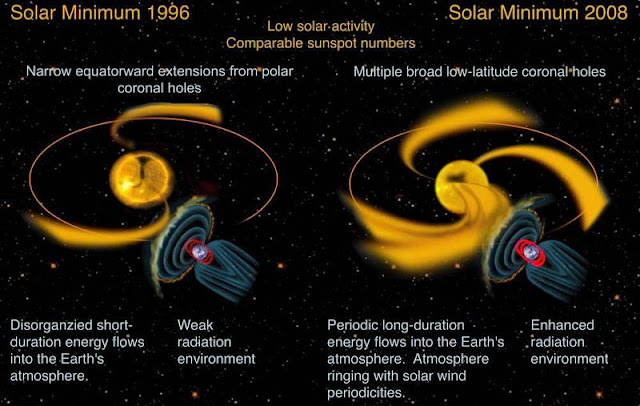Just when it looked like researchers had figured out the mysterious link between sunspot activity and Earth's weather, along comes another solar surprise: As indicators of the impact of the Sun's activity on the planet, sunspots are not all they have been cracked up to be; .. solar surprises
Scientists at the National Center for Atmospheric Research and elsewhere have discovered that Earth was bombarded last year with high levels of solar energy at a time when the Sun was in an unusually quiet phase and sunspots had virtually disappeared. A solar surprise.
"The Sun continues to surprise us," said Sarah Gibson of NCAR in Boulder, Colo., lead author of a study published this week in the Journal of Atmospheric Research, about solar surprises. "The solar wind can hit Earth like a fire hose even when there are virtually no sunspots, and therefore we have some solar surprises."
For centuries, the standard measure of solar activity, and its cycle of roughly 11 years, has been the number of sunspots, the dark patches of concentrated magnetic fields on the surface of the Sun. At solar maximum, the number of sunspots reaches its peak, when intense solar flares occur daily and geomagnetic storms frequently buffet Earth, knocking out satellites and disrupting communications networks. Here could be another solar surprise.
Instead of sunspots, Gibson and colleagues studied another solar phenomenon: discharges of high-speed streams of energy within the solar wind that carry turbulent magnetic fields out into the solar system. Comparing the current solar minimum with measurements during the last minimum in 1996, the researchers found that even though the sunspots were the lowest they have been in 75 years, the Sun's electromagnetic impact on the outer reaches of the atmosphere was three times greater. Going on with more solar surprises.
The research raises interesting new questions about solar physics and the impacts on Earth. Just last month, other NCAR researchers described for the first time how heightened solar activity alters stratopheric winds and, in a series of feedbacks, leads to greater precipitation over the Tropics. Now researchers are wondering how the high-speed streams of energy might have affected Earth in the past when the Sun went through extended periods of low sunspot activity. Of particular interest is a period known as the Maunder Minimum that lasted from about 1645 to 1715 that coincided with a climate episode in the Northern Hemisphere known as the Little Ice Age, where this turned out to quite a large solar surprise.
by "environment clean generations"






 Posted in:
Posted in:
3 comentarii:
These 3x greater impacts on the heliosphere edge----how do we know that the readings are from the sun? Isn't there an oscillation of the energy between the sun and Fluff, the NASA named magnetic field? As myth holds we will enter 2013 as a 'new age' you can see the increasing magnetic field incurring into Sol's heliosphere as a 5,000 y periodicy of the cloud. What happens in 2012---------the cloud releases suddenly. The measurements that NASA gathered that determined E is sitting in a gravity well is correct in this time and place and due of course to the magnetic incursion.
There are indeed objects in the cloud, one of which may be the comet now being tracked but the energy behind the cloud is a neutron star of the bitsy class.
first and foremost i dunno what you mean by "2012, 5,000 y periodicy of the cloud, new age" aso. Are you talking about The Photon Belt? if so that is a whole 'nother thing, that has nothing to do with electromagnetic nature, but with the high energy photons emitted by Alcyone.
A neutron star is a "taboo" thing. Neutron stars, or better said quasars and pulsars are far away into space, like million ly from Earth (see Crab Nebula), and the energy beam released by a neutron star, if it were to hit Earth, the whole life on would vanish in an instant. I also don't understand what u mean by " behind the cloud is a neutron star of the bitsy class."
Post a Comment